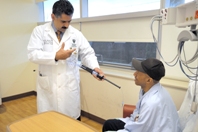
Wayne State University School of Medicine and Oakwood Healthcare System surgeons successfully implanted a new device designed to combat congestive heart failure in a 49-year-old patient. The device could become a leading tool in the arsenal to combat a condition that kills 300,000 Americans annually.
The April 1 surgery took place at Oakwood Hospital & Medical Center in Dearborn. The patient, a Hamtramck man, was suffering from an advanced stage of congestive heart failure.
Surgeons said the patient is "doing well," and was released from the hospital. He was expected to remain in the hospital between five and seven days. The average hospital stay for an open heart surgery patient is eight to 10 days.
The entire procedure took 1 hour and six minutes. Traditional open heart surgery takes hours.
Designated PEERLESS-HF (Prospective Evaluation of Elastic Restraint to LESSen the effects of Heart Failure), the HeartNet therapy researched collaboratively by the School of Medicine and Oakwood Healthcare System involves an implantable device that wraps around the heart to increase its pumping ability.
The HeartNet is an elasticized structure implanted via a minimally invasive procedure. Essentially, the device snugs around and conforms to the heart in a gentle hug, augmenting the function of the heart, and potentially preventing congestive heart failure from advancing by reversing the progressive enlargement of the failing heart. This process allows surgeons to make an incision less than an inch long, opposed to a traditional open heart surgery incision, which can be 12 inches.
Dilated cardiomyopathy, one major cause of congestive heart failure, is a condition in which the heart becomes weakened and enlarged, reducing its ability to pump efficiently. The condition is characterized by a compromising of the heart's ability to squeeze, and often by seepage of fluid into the lungs, feet, legs or abdominal cavity. The heart muscle's inability to keep up with the body's demands can cause the heart to enlarge, increasing stress on the heart wall. The HeartNet counteracts the condition through gentle pressure on the heart.
The American Heart Association and the Heart Failure Society of America estimate that more than 5 million Americans have been diagnosed with heart failure and that 500,000 more diagnoses are made each year. Heart failure is the leading cause of hospital admissions in the U.S. Only about half of Americans diagnosed with heart failure will survive more than five years. Each year, more than 300,000 people die from the condition.
"The potential effects of this study and the HeartNet hold tremendous promise," said Robert M. Mentzer Jr., M.D., dean of the Wayne State University School of Medicine and senior advisor to the president for medical affairs. Dr. Mentzer, a nationally recognized cardiothoracic surgeon who has performed numerous heart transplants, serves as co-principal investigator of the clinical research study, along with Salik A. Jahania, M.D., a cardiothoracic surgeon with the Wayne State University Physician Group and Oakwood Healthcare System. Dr. Jahania performed the procedure.
"More research is needed, but the HeartNet appears to offer the possibility of not only halting but potentially reversing congestive heart failure," Dr. Mentzer said. "The implant could reduce the need for heart transplants among some patients."
Along with Drs. Mentzer and Jahania, Peter Vitkevicius, M.D., and Arthur Riba, M.D., were instrumental in identifying and evaluating patients for the purposes of the study.
The investigational HeartNet is a mesh constructed of nitinol, a nickel-titanium alloy. Because the device conforms to the shape of the heart - expanding and contracting with each beat -- no sutures are required to attach it to the heart. The device is designed as a permanent implant.
The HeartNet is implanted through an incision in the left side of the chest. Implantation is guided by an X-ray camera projecting images on an operating room screen. The tool designed to introduce the HeartNet into the chest cavity contains a number of "fingers" that spread the mesh around the heart, and then retract once the device is properly placed. The procedure can typically be completed in 90 minutes or less.
"We are excited about the possibilities of this therapy, particularly since it offers an alternative to traditional procedures that require a more invasive opening of the chest," said Dr. Jahania. "The heart continues to beat while the device is implanted, and the anticipated recovery period is expected to be shorter."
The Wayne State University School of Medicine was selected as one of 30 international sites for a clinical research study of HeartNet. Oakwood Healthcare System is one of the School of Medicine's health affiliates and has one of the largest open heart programs in metropolitan Detroit, making Oakwood the ideal location for leading-edge clinical trials and studies such as this.
The HeartNet was invented and manufactured by Paracor Medical Inc., based in Sunnyvale, Calif. Paracor plans to enroll patients at up to 30 U.S. centers under an investigational device exemption that has been reviewed and approved by the Food and Drug Administration.